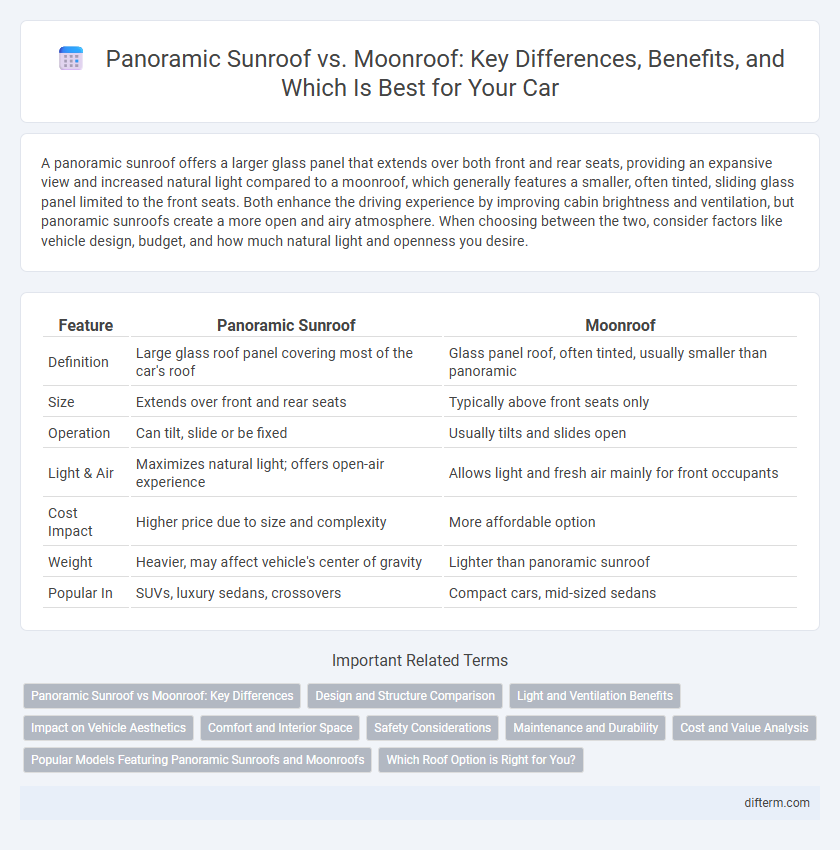A panoramic sunroof offers a larger glass panel that extends over both front and rear seats, providing an expansive view and increased natural light compared to a moonroof, which generally features a smaller, often tinted, sliding glass panel limited to the front seats. Both enhance the driving experience by improving cabin brightness and ventilation, but panoramic sunroofs create a more open and airy atmosphere. When choosing between the two, consider factors like vehicle design, budget, and how much natural light and openness you desire.
Table of Comparison
| Feature | Panoramic Sunroof | Moonroof |
|---|---|---|
| Definition | Large glass roof panel covering most of the car's roof | Glass panel roof, often tinted, usually smaller than panoramic |
| Size | Extends over front and rear seats | Typically above front seats only |
| Operation | Can tilt, slide or be fixed | Usually tilts and slides open |
| Light & Air | Maximizes natural light; offers open-air experience | Allows light and fresh air mainly for front occupants |
| Cost Impact | Higher price due to size and complexity | More affordable option |
| Weight | Heavier, may affect vehicle's center of gravity | Lighter than panoramic sunroof |
| Popular In | SUVs, luxury sedans, crossovers | Compact cars, mid-sized sedans |
Panoramic Sunroof vs Moonroof: Key Differences
Panoramic sunroofs feature large, multi-panel glass roofs that offer expansive natural light and a wide-open view, enhancing the vehicle's interior ambiance. Moonroofs are typically smaller, often tinted, and may include a sliding panel that can be opened or tilted for ventilation. The key difference lies in the size and design--panoramic sunroofs cover a larger portion of the roof, while moonroofs provide limited glass exposure with functional opening options.
Design and Structure Comparison
A panoramic sunroof typically spans a larger portion of the vehicle's roof, often consisting of multiple glass panels that provide an expansive view and increased natural light inside the cabin. In contrast, a moonroof usually features a single, smaller tinted glass panel that tilts or slides open, maintaining more of the vehicle's original roof structure. The design of panoramic sunroofs requires reinforced roof support to maintain structural integrity, whereas moonroofs have a simpler installation with minimal changes to the roof framework.
Light and Ventilation Benefits
Panoramic sunroofs offer extensive light exposure by covering a larger portion of the vehicle roof, enhancing natural brightness and an open-air feeling inside the cabin. Moonroofs, typically smaller and often tinted, provide controlled light entry with the option to tilt or slide open for ventilation without the full visual expansiveness of a panoramic design. Both improve air circulation, but panoramic sunroofs deliver superior airflow and a broader outdoor experience, boosting driver and passenger comfort.
Impact on Vehicle Aesthetics
Panoramic sunroofs enhance vehicle aesthetics by offering expansive glass panels that visually enlarge the cabin and create a modern, open-air ambiance, boosting curb appeal and interior luxury. Moonroofs, typically smaller and often tinted glass panels with sliding or tilting functions, provide subtle sophistication while maintaining a sleek roofline. The choice between panoramic sunroof and moonroof significantly influences the car's exterior styling and perceived value, affecting buyer appeal in the automotive market.
Comfort and Interior Space
A panoramic sunroof enhances comfort by providing expansive natural light and an open-air feeling, significantly increasing the sense of spaciousness inside the vehicle. Moonroofs, typically smaller and opaque when closed, offer a more limited view and light exposure, which can restrict the interior's airy ambiance. The larger glass panels of panoramic sunroofs contribute to improved passenger comfort through greater openness and ventilation options compared to conventional moonroofs.
Safety Considerations
Panoramic sunroofs offer larger glass panels that can increase cabin visibility but may pose higher risks during rollovers due to reduced structural integrity compared to traditional roofs. Moonroofs, typically smaller and often equipped with sliding glass, maintain better roof strength and reduce the likelihood of shattering upon impact. Safety standards for both include laminated or tempered glass to minimize injury from breakage, with manufacturer testing ensuring compliance for crashworthiness and occupant protection.
Maintenance and Durability
Panoramic sunroofs typically require more maintenance due to their larger glass panels and complex mechanisms, which can be prone to leaks and mechanical failures. Moonroofs, being smaller and often made of tinted glass, generally offer greater durability and lower maintenance costs. Regular cleaning and lubrication of seals are essential for both types to ensure longevity and prevent water damage.
Cost and Value Analysis
Panoramic sunroofs typically cost between $1,000 and $2,000 more than moonroofs due to their larger size and enhanced visibility, offering greater cabin openness and luxury appeal. Moonroofs generally provide a cost-effective option, averaging around $800 to $1,200, balancing price with ventilation and light benefits. When considering resale value, vehicles equipped with panoramic sunroofs often experience higher appreciation in the luxury and mid-range segments compared to those with standard moonroofs.
Popular Models Featuring Panoramic Sunroofs and Moonroofs
Popular automotive models featuring panoramic sunroofs include the Mercedes-Benz GLC, BMW X5, and Audi Q5, offering expansive glass roofs that enhance interior light and visibility. Moonroof-equipped vehicles like the Honda CR-V, Toyota RAV4, and Ford Escape provide tilt-and-slide glass panels with sunshade options, balancing ventilation and sun protection. Choosing between panoramic sunroofs and moonroofs often depends on preferences for size, airflow, and aesthetic appeal in SUVs and sedans.
Which Roof Option is Right for You?
Choosing between a panoramic sunroof and a moonroof depends on your preference for visibility and ventilation in your vehicle. Panoramic sunroofs offer expansive glass panels that provide an unobstructed view and ample natural light, ideal for those seeking a spacious, open-air driving experience. Moonroofs typically feature a smaller, tinted glass panel that tilts or slides open for ventilation while maintaining privacy and sun protection, making them suitable for drivers prioritizing comfort and climate control.
panoramic sunroof vs moonroof Infographic

 difterm.com
difterm.com